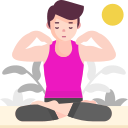Build the Habit: Track, Celebrate, and Stay Safe
Link breathing to daily cues: doorways, app logins, kettle boils, or seatbelts. One slow inhale, longer exhale each time. Tiny repetitions build reliability when stress spikes. Comment with your favorite anchor so readers can borrow it, and we will feature the most creative ideas next week.
Build the Habit: Track, Celebrate, and Stay Safe
After each practice, note one sensation, one thought, and one word for your mood. It is enough. Over time, you will notice patterns and progress. Share a snapshot of your notes or a single sentence that captures how breathing shifted your day’s tone.










